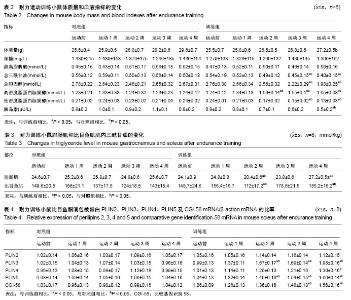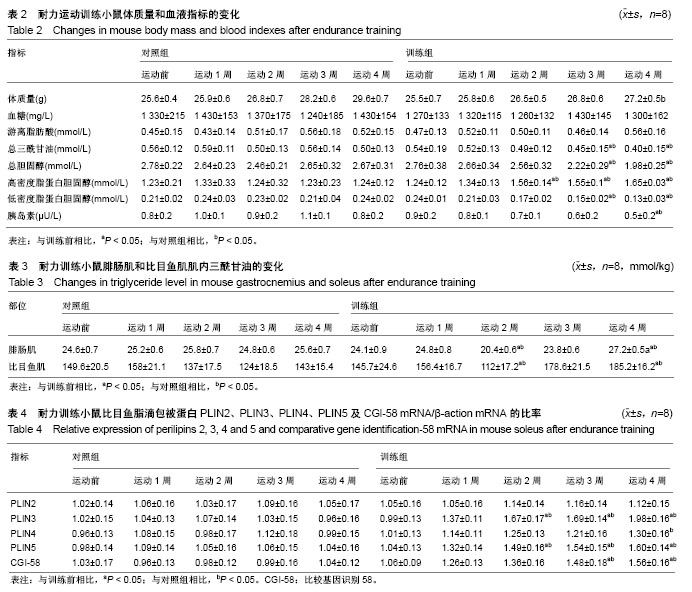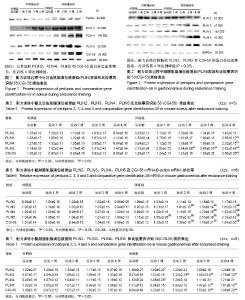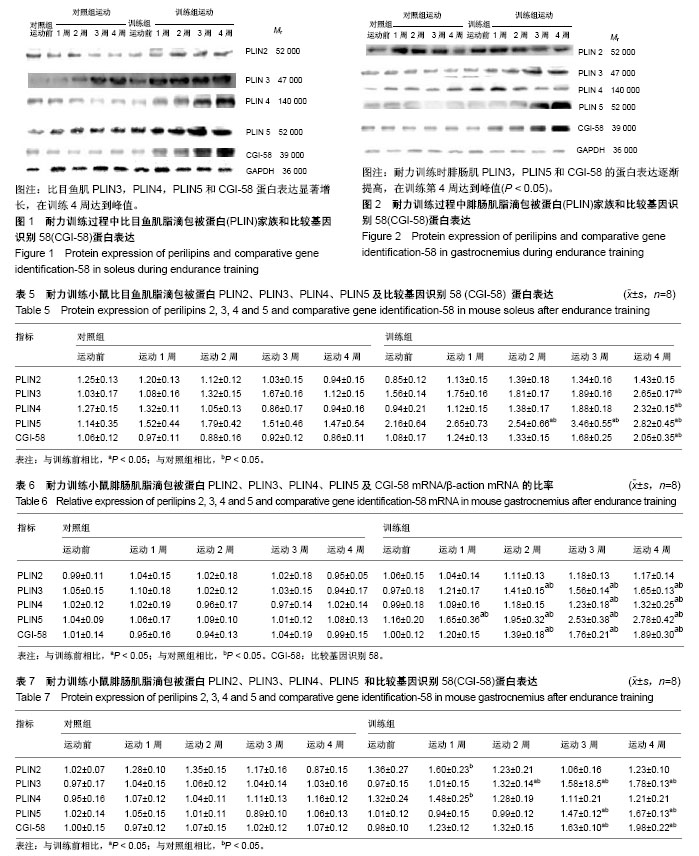| [1] Watt MJ, Cheng Y. Triglyceride metabolism in exercising muscle. Biochim Biophys Acta. 2017;1862(10 Pt B): 1250-1259. [2] Noland RC. Exercise and Regulation of Lipid Metabolism// Bouchard C. Progress in Molecular Biology and Translational Science. 2015:39-74. [3] Yao-Borengasser A, Varma V, Coker RH, et al. Adipose triglyceride lipase expression in human adipose tissue and muscle. Role in insulin resistance and response to training and pioglitazone. Metabolism. 2011;60(7):1012-1020. [4] Bai X, Li H, Yang W, et al. Sequence of fat partitioning and its relationship with whole body insulin resistance. Chin Med J (Engl). 2010;123(24):3605-3611. [5] Ramos SV, Turnbull PC, MacPherson RE. Adipose tissue depot specific differences of PLIN protein content in endurance trained rats. Adipocyte. 2016;5(2):212-223. [6] Brasaemle DL. The perilipin family of structural lipid droplet proteins: stabilization of lipid droplets and control of lipolysis. J Lipid Res. 2007;48(12):2547-2559. [7] Ducharme NA, Bickel PE. Minireview: Lipid droplets in lipogenesis and lipolysis. Endocrinology. 2008;149(3):942-949. [8] Hayward GC, Fenech RK, Yang AJ, et al. The role of PLIN protein in healthy lipid storage and lipid droplet expansion. J Physiol. 2017;595(24):7273-7274. . [9] 杨勇,马长伟,赵春江,等.ATGL、CGI-58及其对脂肪水解的作用[J].中国油脂,2011,36(9):34-38.[10] Badin P, Loubiere C, Coonen M, et al. Regulation of skeletal muscle lipolysis and oxidative metabolism by the co-lipase CGI-58. J Lipid Res. 2012;53(5):839-848. [11] MacPherson RE, Ramos SV, Vandenboom R, et al. Skeletal muscle PLIN proteins, ATGL and CGI-58, interactions at rest and following stimulated contraction. Am J Physiol Regul Integr Comp Physiol. 2013;304(8):R644-R650. [12] Vigelso A, Gram M, Dybboe R, et al. The effect of age and unilateral leg immobilization for 2 weeks on substrate utilization during moderate-intensity exercise in human skeletal muscle. J Physiol. 2016;594(8):2339-2358. [13] Bae JY, Woo J, Roh HT, et al. The effects of detraining and training on adipose tissue lipid droplet in obese mice after chronic high-fat diet. Lipids Health Dis. 2017;16(1):13. [14] Lundby C, Jacobs RA. Adaptations of skeletal muscle mitochondria to exercise training. Exp Physiol. 2016;101(1): 17-22. [15] Yamaguchi T, Omatsu N, Matsushita S, Osumi T. et al. CGI-58 interacts with perilipin and is localized to lipid droplets -Possible involvement of CGI-58 mislocalization in Chanarin-Dorfman syndrome. J Biol Chem. 2004;279(29): 30490-30497. [16] Hughson RL, Faisal A. On the method of fitting cardiac output kinetics in severe exercise. Eur J Appl Physiol. 2011;111(7): 1529-1531. [17] Granneman JG, Moore HP, Krishnamoorthy R, et al. Perilipin controls lipolysis by regulating the interactions of AB-hydrolase containing 5 (Abhd5) and adipose triglyceride lipase (Atgl). J Biol Chem. 2009;284(50):34538-34544. [18] Souza SC, Muliro KV, Liscum L, et al. Modulation of hormone-sensitive lipase and protein kinase A-mediated lipolysis by perilipin A in an adenoviral reconstituted system. J Biol Chem. 2002, 277(10):8267-8272. [19] Kimmel AR, Brasaemle DL, McAndrews-Hill M, et al. Adoption of PERILIPIN as a unifying nomenclature for the mammalian PAT-family of intracellular lipid storage droplet proteins. J Lipid Res. 2010;51(3):468-471. [20] Wolins NE, Quaynor BK, Skinner JR, et al. OXPAT/PAT-1 is a PPAR-induced lipid droplet protein that promotes fatty acid utilization. Diabetes. 2006;55(12):3418-3428. [21] Beylot M, Neggazi S, Hamlat N, et al. Perilipin 1 ablation in mice enhances lipid oxidation during exercise and does not impair exercise performance. Metabolism. 2012;61(3): 415-423. [22] Vigelso A, Gram M, Wiuff C, et al. Effects of immobilization and aerobic training on proteins related to intramuscular substrate storage and metabolism in young and older men. Eur J Appl Physiol. 2016;116(3):481-494. [23] MacPherson RE, Peters SJ. Piecing together the puzzle of perilipin proteins and skeletal muscle lipolysis. Appl Physiol Nutr Metab. 2015;40(7):641-651. [24] Badin PM, Langin D, Moro C. Dynamics of skeletal muscle lipid pools. Trends Endocrinol Metab. 2013;24(12):607-615. [25] Bosma M, Minnaard R, Sparks L M, et al. The lipid droplet coat protein perilipin 5 also localizes to muscle mitochondria. Histochem Cell Biol. 2012;137(2):205-216. [26] Bosma M, Sparks LM, Hooiveld GJ, et al. Overexpression of PLIN5 in skeletal muscle promotes oxidative gene expression and intramyocellular lipid content without compromising insulin sensitivity. Biochim Biophys Acta. 2013;1831(4): 844-852. [27] Kuramoto K, Okamura T, Yamaguchi T, et al. Perilipin 5, a lipid droplet-binding protein, protects heart from oxidative burden by sequestering fatty acid from excessive oxidation. J Biol Chem. 2012; 287(28):23852-23863. [28] Mason RR, Mokhtar R, Matzaris M, et al. PLIN5 deletion remodels intracellular lipid composition and causes insulin resistance in muscle. Mol Metab. 2014;3(6):652-663. [29] Macpherson RE, Vandenboom R, Roy BD, et al. Skeletal muscle PLIN3 and PLIN5 are serine phosphorylated at rest and following lipolysis during adrenergic or contractile stimulation. Physiol Rep. 2013;1(4):e84. |



